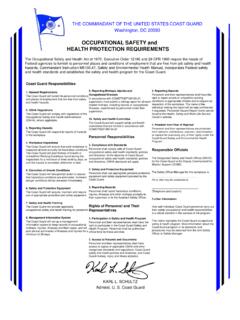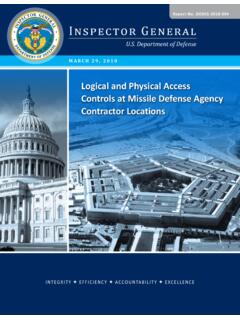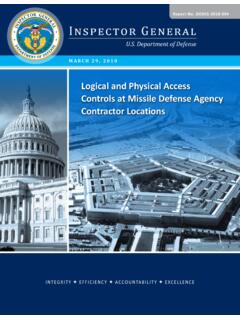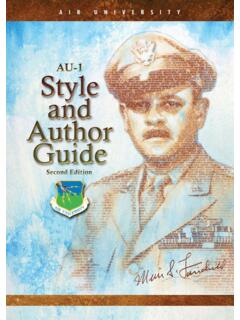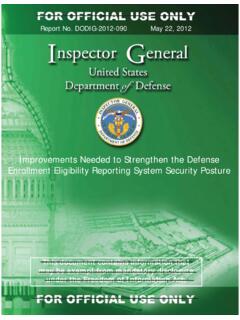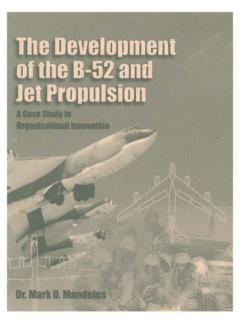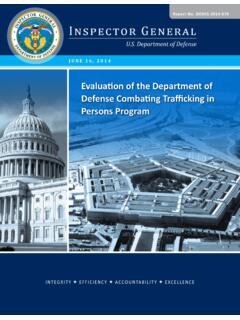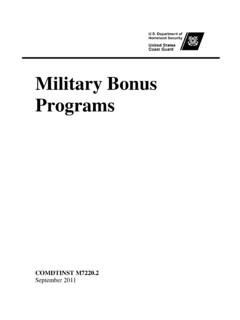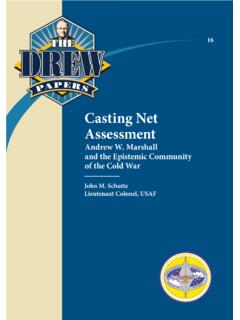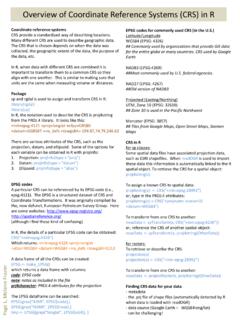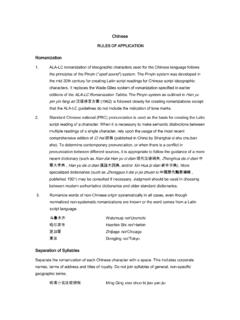Transcription of U.S. Department of Defense Counter-Small Unmanned Aircraft ...
1 Department of DefenseCounter-Small Unmanned Aircraft Systems StrategyMESSAGE FROM THE ACTING SECRETARYC hallenges to the Joint Force are more complex and varied than at any other time. Rapid technological change has aided in disrupting the international rules-based order. Small Unmanned Aircraft systems (sUAS) were previously viewed as hobbyist toys, but today it is evident that the potential for hazards or threats has the ability to impact the Joint Force. Our initial efforts were intended to meet the immediate needs of Services and combatant commanders.
2 However, as technology and proliferation of sUAS continue to advance at a pace that challenges the Department s ability to respond effectively within current paradigms, it is evident that we cannot rely on materiel solutions alone. Instead, we must re-examine how to counter the growing challenges sUAS present to the Joint Force by considering and developing solutions that span the entirety of the Doctrine, Organization, Training, Materiel, Leadership and Education, Personnel, Facilities Policy (DOTMLPF-P) spectrum. This strategy provides the framework for addressing sUAS across the spectrum from hazard to threat in the homeland, host nations, and contingency locations.
3 As technology and systems evolve, this strategy will require ongoing assessments to ensure the Department keeps pace. Success will require unity of effort across all of DoD s stakeholders. The Military Departments, combatant commands, Joint Staff, and other DoD Components will maintain constant vigilance of sUAS and ensure the United States and its allies and partner nations maintain the most effective response. Christopher C. MillerActing Secretary of DefenseThis Page Intentionally Left Blank1| Department of Defense | Counter - sUAS StrategyTABLE OF CONTENTST able of ContentsEXECUTIVE SUMMARY 3 INTRODUCTION 4 SECURITY ENVIRONMENT 6A NEW STRATEGIC APPROACH
4 10 Line of Effort 1: READY THE FORCE 12 Line of Effort 2: DEFEND THE FORCE 14 Line of Effort 3: BUILD THE TEAM 16 CONCLUSION 18 Annex A Glossary 21 Annex B Governance 28 Annex C Unmanned Aircraft system Categorization
5 29 Annex D References 30 Department of DefenseCounter-sUAS StrategyFRONT COVER Marine Corps 1st Lt. Taylor Barefoot programs a counter- Unmanned Aircraft system on a Marine Defense vehicle during a training exercise at Marine Corps Air Ground Combat Center Twentynine Palms, Calif., Nov. 13, 2018. ( Marine Corps photo by Lance Cpl. Dalton Swanbeck) BACK Army Soldier assigned to Headquarters and Headquarters Company, 3rd Battalion, 187th Infantry Regiment, 3rd Brigade Combat Team, 101st Airborne Division (Air Assault), launches the RQ-11 Raven during platoon live fire exercise at Fort Campbell, Ky.
6 , Jan. 25, 2018. ( Army Photo by Capt. Justin Wright)This Page Intentionally Left Blank3| Department of Defense | Counter - sUAS StrategyThe exponential growth of small Unmanned Aircraft systems (sUAS) creates new risks for the Department of Defense (DoD). Technology trends are dramatically transforming legitimate applications of sUAS while simultaneously making them increasingly capable weapons in the hands of state actors, non-state actors, and criminals. Small UAS may also pose hazards to DoD operations in the air, land, and maritime domains when controlled by negligent or reckless operators.
7 The Department must protect and defend personnel, facilities, and assets in an environment where increasing numbers of sUAS will share the skies with DoD Aircraft , operate in the airspace over DoD installations, and be employed by our Nation s response to this challenge, the Department initially emphasized the deployment and employment of government and commercially-built materiel to address the immediate risks posed by sUAS; however, it resulted in many non-integrated, redundant solutions.
8 Although the initial approach addressed near-term requirements, it also introduced challenges that complicated the Department s ability to keep pace with a constantly evolving problem. To address these challenges, the DoD requires a Department -wide holistic strategy for countering sUAS hazards and November 2019, the Secretary of Defense designated the Secretary of the Army (SECARMY) as the DoD Executive Agent (EA) for Counter-Small Unmanned Aircraft Systems (C-sUAS, Unmanned Aircraft groups 1, 2, and 3).
9 In his capacity as EA, the SECARMY established the Joint C-sUAS Office (JCO), which will lead, synchronize, and direct C-sUAS activities to facilitate unity of effort across the DoD C-sUAS strategy provides the framework for addressing sUAS across the spectrum from hazard to threat in the homeland, host nations, and contingency locations. Department stakeholders will work collaboratively to achieve three strategic objectives: (1) enhance the Joint Force through innovation and collaboration to protect DoD personnel, assets, and facilities in the homeland, host nations, and contingency locations; (2) develop materiel and non-materiel solutions that facilitate the safe and secure execution of DoD missions and deny adversaries the ability to impede our objectives.
10 And (3) build and broaden our relationships with allies and partners to protect our interests at home and abroad. The Department will address these objectives by focusing on three lines of effort: Ready the Force; Defend the Force; and Build the Team. To Ready the Force, DoD will maximize current C-sUAS capabilities and use a risk-based approach to guide efficient and rapid development of a suite of materiel and non-materiel solutions to address emerging requirements. To Defend the Force, DoD will coordinate the delivery of joint capabilities underpinned by DOTMLPF-P consideration and synchronize the development of operational concepts and doctrine.
